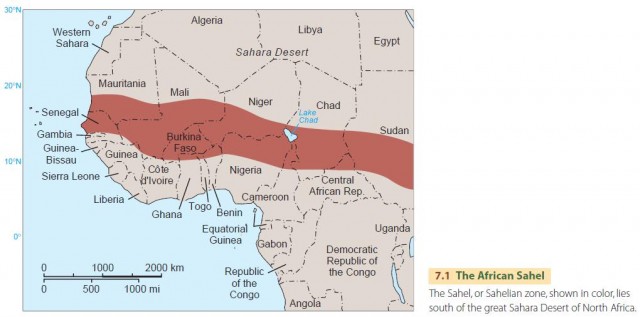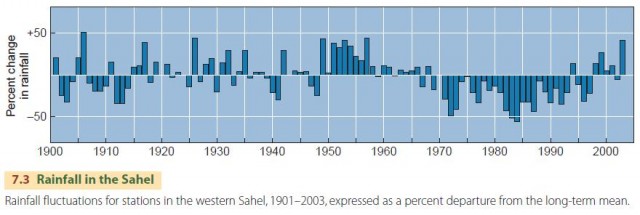Drought in the African Sahel
One of the Earth's more distinctive climates is the wetdry tropical climate . Here, the weather is largely dry for much of the year, but there is a rainy season of a few months duration in which most of the annual rainfall occurs. Precipitation during the wet season is quite variable, ranging from little or none to torrential rainfalls that produce severe local flooding.
The wet-dry tropical climate is subject to large annual differences in rainfall. Climate records show that two or three successive years of abnormally low rainfall (a drought) typically alternate with several successive years of average or higher than average rainfall. Variability is a permanent feature of this climate, and both the human inhabitants and natural ecosystems are well adjusted to it.
However, there is one region where the alternation between wet and dry years takes place on a much longer time scale. Africa's Sahel region (Figure 7.1), sandwiched between the continent's monsoon forests and the Sahara Desert, is a band of wet-dry tropical climate with a history of wet and dry periods that are decades long. Because the wet periods are long enough for natural ecosystems and human activities to expand their productive range, the long droughts experienced in this region can be particularly devastating.

Although there has been least one severe Sahelian drought in each of the last four centuries, the drought of the late twentieth century, which began in 1968 and ran through the mid-1980s with only one brief respite, was an environmental disaster of the first magnitude. Famine killed about 100,000 people, left three-quarters of a million people dependent on food aid, and severely impacted the agriculture, livestock, and human populations of the region (Figure 7.2).

As scientists tried to explain the duration and severity of the late-twentieth-century drought, they first thought that it might have been caused by human activity through overgrazing and conversion of woodland to agriculture—a process called desertification or land degradation. These activities reduce precipitation by decreasing atmospheric moisture and by raising the surface albedo, which reduces local convective circulation and convective rainfall.
Recent studies now suggest, however, that drought in the Sahel is linked to large-scale atmospheric circulation changes that are produced by multidecadal variations in global sea-surface temperature. A pattern of sea-surface temperatures develops in the Pacific, Atlantic, and Indian oceans that weakens the African monsoon circulation, reducing or eliminating the Sahel's brief rainy season. Since the pattern can persist for a number of years, the drought produced can be quite long-lasting.
But sea-surface temperature alone is not sufficient to explain the magnitude of the late-twentieth-century Sahelian drought. It now appears that severe drought in the Sahel was produced by a combination of factors acting synergistically, including sea-surface temperature change, the retreat of natural vegetation cover in the face of drought, and changing human land use.

At present, rainfall in the Sahel is somewhat below historical levels, although drought is not severe (Figure 7.3). Will the devastating droughts of the 1970s and 1980s return? Some global climate models predict that global warming will lead to the persistence of sea-surface temperature patterns that trigger a Sahelian drought. Coupled with the fact that Sahelian population is doubling every 20 years, the outlook for the Sahel is not very favorable.